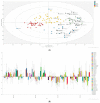Vaginal and Cervical Microbiota Composition in Patients with Endometrial Cancer
- PMID: 37175971
- PMCID: PMC10179515
- DOI: 10.3390/ijms24098266
Vaginal and Cervical Microbiota Composition in Patients with Endometrial Cancer
Abstract
According to recent data, changes in the vaginal microbiota could affect the risk of gynaecological cancers. Women suffering from endometrial cancer present significant changes in cervicovaginal microbiota composition. The objective of our study was to characterize the cervicovaginal microbiota of women undergoing hysterectomy due to benign disease, atypical hyperplasia, and endometrial cancer; The study included 96 patients, who undergone surgical treatment due to benign uterine disease, precancerous endometrial lesion, and endometrial cancer. Quantitative and qualitative real-time PCR analysis of DNA isolated from vaginal fornix and endocervical canal samples was performed to detect the 19 most commonly identified microorganisms, including different Lactobacillus spp., Atopobium, Bifidobacterium, Chlamydia, and Gardnerella; At least one of the tested microorganisms was identified in 88.5% of vaginal and 83.3% of cervical samples. Lactobacillus iners was significantly more frequent in patients with benign condition, whereas Dialister pneumosintes and Mobiluncus curtisii was more frequent in cancer patients; Mobiluncus curtisi and Dialister pneumosintes, which were identified as significantly more common in endometrial cancer vaginal samples, may be considered as potential endometrial cancer co-factors which promote/stimulate carcinogenesis. However, the exact mechanism of such activity remains unexplained and requires further investigations.
Keywords: Dialister; Lactobacillus; Mobiluncus; endometrial cancer; microbiome.
Conflict of interest statement
The authors declare no conflict of interest.
Figures




References
-
- Liu Y., Ko E.Y.-L., Wong K.K.-W., Chen X., Cheung W.-C., Law T.S.-M., Chung J.P.-W., Tsui S.K.-W., Li T.-C., Chim S.S.-C. Endometrial Microbiota in Infertile Women with and without Chronic Endometritis as Diagnosed Using a Quantitative and Reference Range-Based Method. Fertil. Steril. 2019;112:707–717.e1. doi: 10.1016/j.fertnstert.2019.05.015. - DOI - PubMed
MeSH terms
Substances
Supplementary concepts
Grants and funding
LinkOut - more resources
Full Text Sources
Medical
Miscellaneous

